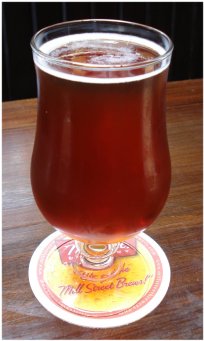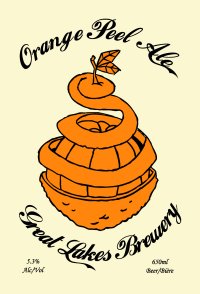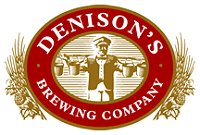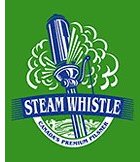This article was originally written in October 2006 for the now-defunct food and drink website Gremolata. It was re-published here in September 2011, but back-dated to appear in the blog archives close to its original publication date.
To most North Americans who have grown up drinking mainstream lagers that taste like rancid corn juice once they inch above near-freezing, the idea of drinking warm beer is positively stomach churning. That might be why there are so many derisive jokes about the British and their supposed love of warm beer. While there is a grain of truth in this stereotype, there are two very important factors to keep in mind:
1) “Warm” is this context means cellar temperature, or roughly 55 degrees Fahrenheit.
2) “Beer” is this context means traditional ales like bitters, pale ales and strong ales, not the adjunct-laden light lagers and golden ales that the big brewers specialize in.
To most beer aficionados, the best way to enjoy one of these traditional ale styles is in it’s most traditional state – unfiltered, unpasteurised and dispensed without artificial carbonation. Known as cask ale or real ale, this method of storing and dispensing beer is how things were done for centuries before the development of bottling, refrigeration, pasteurisation and pressurised kegs (not to mention the increasing popularity of light lager styles) all combined to drive these traditional ales to the brink of extinction. By the 1970s, traditional ales had all but disappeared from British pubs, and were a little-remembered relic of bygone days in North America.
However, thanks to the efforts of the Campaign for Real Ale (CAMRA), the traditional British pub ale was saved from almost certain death. With a fervour that verges on the religious, the CAMRA folks have fought to save what they describe as “beer brewed from traditional ingredients, matured by secondary fermentation in the container from which it is dispensed, and served without the use of extraneous carbon dioxide.” 35 years after it was formed by four drinkers who just wanted to find a decent pint, CAMRA now boasts over 80,000 members around the world, and has helped to push cask ale to the forefront of the craft and micro brew movement.
Here in Ontario, the resurgence of cask ale can be traced back to Guelph’s Wellington Brewery, where they’ve been producing cask versions of their ales for over 20 years. In fact, they were the first modern North American brewery to offer real ales, and their Arkell Best Bitter and County Ale remain popular choices for Ontario publicans who serve cask-conditioned brews. In the subsequent two decades, other Ontario brewers including Granite Brewery, County Durham, Black Oak and Scotch-Irish have joined the cask ale revolution, often augmenting the cask versions of their beers with extra hopping, aging in whiskey barrels, and other unique twists.
The main drawback of cask ales is that they require much more care and attention than pasteurised and pressured kegs. It takes an experienced publican to properly store, tap and serve cask ale, and an honest one to keep an eye on the quality of the beer in order to ensure that it is not served once it is past its prime, which is generally three days or so after the keg is tapped. (Some pubs use a device called a cask breather to replace the oxygen in the cask with a small amount of carbon dioxide, which will help extend the freshness of the beer, although some purists consider this to be against the real ale philosophy and frown upon it.) As a result, there are very few pubs that are willing to take on the responsibility of serving cask ale, and places that do so are generally given strong support from local beer lovers.
One of Toronto’s strongest advocates of cask ale is Ralph Morana, the owner of cozy Italian eatery Volo (587 Yonge St.) which has unexpectedly become one of Toronto’s top beer hot-spots in the last couple of years. In addition to having two handpumps pouring a rotating selection of cask ales on a regular basis, Volo is also the location of Toronto’s first and only all-cask beer festival, the annual Volo Cask Days, with this year’s edition taking place on Saturday, October 21st. Over the course of two 5-hour sessions, attendees will be able to enjoy cask ales – and even a couple of unfiltered, unpasteurised lagers – from 21 Ontario breweries and homebrewers, plus a special guest from Quebec, the renowned brewpub Dieu Du Ciel. Some of the more anticipated beers at the festival include Black Oak’s H&H Overkill, a variation on their Pale Ale brewed with extra hops and jalapenos (“pronounced Halapenooooo!!!!”); Neustadt Springs Brewery‘s Big Dog Beaujolais Porter, which is their seasonal Big Dog Porter aged in a wine barrel; Heritage Brewing‘s Smokin’ Maple, brewed with maple sap and Bamberg smoked malt; and a Pear Ginger Oatmeal Stout from homebrewer George Eagleson.
While this event would be a great place for a cask ale newcomer to get their feet wet, it has been sold out for weeks, so if you don’t have a ticket you can try dropping by Volo on Sunday when the leftovers – should there be any – will be available for general sale. Alternatively, if you can’t make it to Volo this weekend but would still like to try a pint or two of cask ale, you can always visit one of the pubs listed below, all of which offer cask ale on a regular basis.
Just remember: when it comes to cask ale, fresher is better, so make a point of asking your server when the cask was tapped before placing your order. If it’s been more than three days, or they don’t know the answer, you’re better off sticking with the kegged stuff until you can find a cask that is guaranteed to be fresh.
The Bow & Arrow (1954 Yonge St.) –three casks, rotating between different beers
C’est What (67 Front St. E.) – five casks, one dedicated to their Al’s Cask Ale house beer & four rotating
Cloak & Dagger (394 College St.) – one cask, Wellington
Dora Keogh (141 Danforth Ave.) – one cask, as well as a second handpump serving Fuller’s London Porter from a keg without additional carbonation
The Duke of Kent (2315 Yonge St.) – one cask, Wellington
The Feathers (962 Kingston Rd.) – one cask, Wellington
Granite Brewery (245 Eglinton Ave E.) – two casks, Granite Best Bitter Special & Granite IPA
Smokeless Joe (125 John St.) – one cask, County Durham
Victory Caf̩ (581 Markham St.) Рone cask, rotating
Volo (587 Yonge St.) – two casks, rotating
 While I’m usually inclined to reach for a nice dry Pilsner or a hoppy Pale Ale when the weather gets warmer, I can understand the increased popularity of fruit beers in the summer months. Their fresh and lively flavours are a reminder of the warm weather harvest, and the often complex combination of sweetness and tartness that is found in many better quality fruit beers can be quite refreshing on a hot day.
While I’m usually inclined to reach for a nice dry Pilsner or a hoppy Pale Ale when the weather gets warmer, I can understand the increased popularity of fruit beers in the summer months. Their fresh and lively flavours are a reminder of the warm weather harvest, and the often complex combination of sweetness and tartness that is found in many better quality fruit beers can be quite refreshing on a hot day.
 In a local craft beer scene that has seen its fair share of well-intentioned failures, Etobicoke’s
In a local craft beer scene that has seen its fair share of well-intentioned failures, Etobicoke’s 


